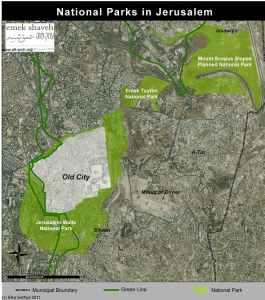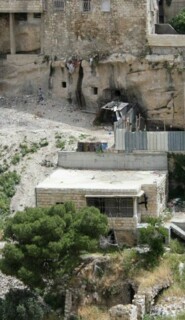Settlement through Excavation
Natasha Roth
‘Settlement through excavation is the same as settlement through building,’ according to Yonathan Mizrachi, an archaeologist who works withEmek Shaveh in Jerusalem. The organisation explores the connection between archaeology and politics in Israel and Palestine, particularly in and around Jerusalem. Earlier this year it published a report, written by Mizrachi, called From Territorial Contiguity to Historical Continuity: Asserting Israeli Control through National Parks in East Jerusalem.
The Jerusalem Walls National Park – now more commonly known as the City of David National Park – was created in 1974, seven years after Israel occupied in East Jerusalem during the Six Day War. The western part of the Hinnom Valley between West Jerusalem and the Palestinian village of Silwan became Israeli land, and the valley as a whole part of the park, under the auspices of the Israel Antiquities Authority (IAA) and the Nature and Parks Authority (NPA). According to Mizrachi, the government intended from the outset to absorb Jerusalem’s Palestinian neighbourhoods into the park. Israeli excavations across the Hinnom Valley have led to tourist sites and their infrastructure creeping towards Silwan and other Palestinian areas of Jerusalem.
A view of Silwan from the City of David park
Israel’s encroachment on Silwan was kept in check during much of the 1970s and 1980s: Teddy Kollek, the mayor of Jerusalem from 1967 to 1993, was opposed (on pragmatic grounds) to Jewish settlement in East Jerusalem. In the mid-1980s, however, the situation began to change. Ariel Sharon, when he was minister of housing and construction in the early 1990s, transferred dozens of properties in East Jerusalem to settler organisations. One of them, Elad (a Hebrew acronym for ‘to the City of David’), began funding excavations in the City of David Park in 1994, using money the origins of which it has special permission not to declare. Its explicit goal is to create a Jewish majority in Palestinian areas of Jerusalem. In late 1997, a year after Binyamin Netanyahu was elected prime minister for the first time, the government transferred control over the entire City of David Park, and the excavations beneath it, to Elad. Objections from the IAA and a number of court cases stalled the transfer, but by 2002 Elad’s takeover was complete.
Also in the late 1990s, the Emek Tzurim National Park was created, covering ground across the lower reaches of the Mount of Olives and the upper Kidron Valley. An extension of the City of David Park, Emek Tzurim also encompasses land belonging to the Palestinian neighbourhoods A-Sawaneh and A-Tur. Since 2005 it has been the site of the ‘Temple Mount Sifting Project’, an Elad-sponsored tourist activity. ‘Its scientific significance was doubtful from the outset,’ the Emek Shaveh report says. ‘The initiative is a key tool in the political struggle to justify Israeli involvement and presence on the Temple Mount.’
In 2010, 22 homes in Silwan’s al-Bustan (‘orchard’) neighbourhood were threatened with demolition as part of the ‘King’s Garden plan’. The proposal, backed by the government’s disputed claim that the area was once the site of the gardens of ancient Israelite kings, is currently on hold following international criticism, but has not been abandoned. A park on the slopes of Mount Scopus, which would swallow up much of the village of Issawiya, has been planned since 2011, but is similarly stalled. Refaim Park was approved last year. It will include land belonging to al-Walaja, a village already strangled by the Separation Wall. According to the Israeli NGO Bimkom, further parks are proposed in Bab as-Sahrah and Ash-Sheikh Jarrah, north of the Old City. A huge visitors’ centre is planned for Silwan.
Palestinians living in areas undergoing excavations are facing displacement, dispossession and damage to or destruction of their property. In Silwan, digging under residents’ homes has been responsible for collapsing streets, sinkholes and structural damage. Elad and the Israeli government are enjoying, respectively, financial and political benefits from the project. There are half a million visitors a year to the City of David centre in Silwan alone, bringing in revenue which Elad does not disclose. For the government, the establishment of national parks is a useful tool to mollify far-right members of the coalition: Netanyahu approved the Mount Scopus park plan earlier this year in part to appease colleagues angry at the release of Palestinian prisoners. The move was reminiscent of similar announcements in the past, when new settlement blocs have been approved in order to counterbalance any apparently ‘dovish’ concessions by the government.
The government has a ‘reward and punishment’ approach to land appropriations; the rewards for right-wing Israelis are matched by punishments for Palestinians, such as the recent announcement of a takeover of nearly 4000 dunams of land in the West Bank. This seizure, which is intended to create a new settlement, Gvaot, as well as expanding the wider Gush Etzion bloc towards Jerusalem, is a response to the kidnapping and murder of three Israeli teenagers in July. It was declared just a few days after the government reached a ceasefire agreement with Hamas following the 50-day war in the Gaza Strip.
The abuse of archaeology in order to squeeze Palestinians and their history out of Jerusalem is only one manifestation of the growing influence of settler ideology in the Knesset. A unified capital city, under full Israeli control, is one of the right wing’s most important goals, and a major obstacle to any resolution of the conflict.


Comments
First, there is no "Palestine". The use of this term is misleading and factually wrong: There is no such entity, neither historically nor in the current political international system.
Second, the summering claim that "The abuse of archaeology in order to squeeze Palestinians and their history out of Jerusalem is only one manifestation of the growing influence of settler ideology in the Knesset."
is somewhat amusing, as Palestinians, and for that matter Muslims, do not have real history nor theological roots in Jerusalem (as attested by the fact that Jerusalem is not referred to in the Koran).
It seems that this small piece has more to do with politics then serious understanding of the issue.
The Koran, like the Torah, has its many adherents. But neither are universally recognized under international law. In the matter of the occupied territories, the governing legal precepts are the Geneva Conventions.
Need I remind you: on the other side of that line, the Geneva Conventions apply. The Israel military and government have a special responsibility for the subject population of the occupied territories (ie, collective punishment, forced relocation & expatriation etc etc etc are war crimes under international law).
Politics, regrettably, has everything to do with serious understanding of this issue.
As to the issue of Israeli archeological digs in the West Bank! These have provided some interesting historical artifacts supporting Palestinian claims to the historical continuity of their culture & settlement in the region. Quite a bit of that research has been suppressed - inconvenient to the prevailing Israeli political narrative, you understand.